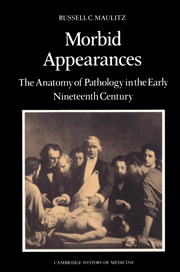Book contents
- Frontmatter
- Contents
- Dedication
- Preface
- Introduction: Ouverture: Bichat's head
- PART ONE PARIS
- PART TWO CHANNEL CROSSING
- PART THREE LONDON
- 7 After Waterloo: Medical journalism and the surgeon-apothecaries
- 8 Pathology and the specialist: The London Academy of Minute Anatomy
- 9 Propagation
- Conclusion: A language of morbid appearances
- Appendix: Transcription and translation of Figure 1.1
- Notes
- Selected bibliography
- Index
8 - Pathology and the specialist: The London Academy of Minute Anatomy
Published online by Cambridge University Press: 22 September 2009
- Frontmatter
- Contents
- Dedication
- Preface
- Introduction: Ouverture: Bichat's head
- PART ONE PARIS
- PART TWO CHANNEL CROSSING
- PART THREE LONDON
- 7 After Waterloo: Medical journalism and the surgeon-apothecaries
- 8 Pathology and the specialist: The London Academy of Minute Anatomy
- 9 Propagation
- Conclusion: A language of morbid appearances
- Appendix: Transcription and translation of Figure 1.1
- Notes
- Selected bibliography
- Index
Summary
In 1835 Adolph Muehry, a Hanover physician and surgeon, followed time-honored custom with a Grand Tour of British and European medical institutions. In the next year he published his notes on the relative state of medicine in his native Germany alongside that of England and France. Surveying the development of pathological anatomy in England, Muehry identified a succession of medical men who had been most active in furthering the traditions of English morbid anatomy. He singled out the work of Matthew Baillie (1761–1823) and John Hunter (1728–1793) in the late eighteenth century. He noted that they had been followed by one individual, John Richard Farre (1775–1862), and that Farre in turn had been more lately succeeded by a new group ascendant in the 1830s. Among the latter group Muehry numbered Richard Bright, Thomas Hodgkin, and Robert Carswell.
Muehry's three groups, each separated from the next by half a generation, provide appropriate guideposts around which to locate the changing fortunes of English pathological anatomy in the early nineteenth century. Only the first and third of these “generations,” that of Hunter and Baillie and that of Bright, Hodgkin, and Carswell, are in any detail known to the twentieth century historian. But if, over the critical half-century 1790–1840, each group of physicians was disposed toward certain intellectual predilections, social groups, and professional sensibilities, who was this “missing link”? Who was John Farre?
John Richard Farre had practiced medicine in his native West Indies before seeking to establish a London medical career.
- Type
- Chapter
- Information
- Morbid AppearancesThe Anatomy of Pathology in the Early Nineteenth Century, pp. 175 - 197Publisher: Cambridge University PressPrint publication year: 1987



